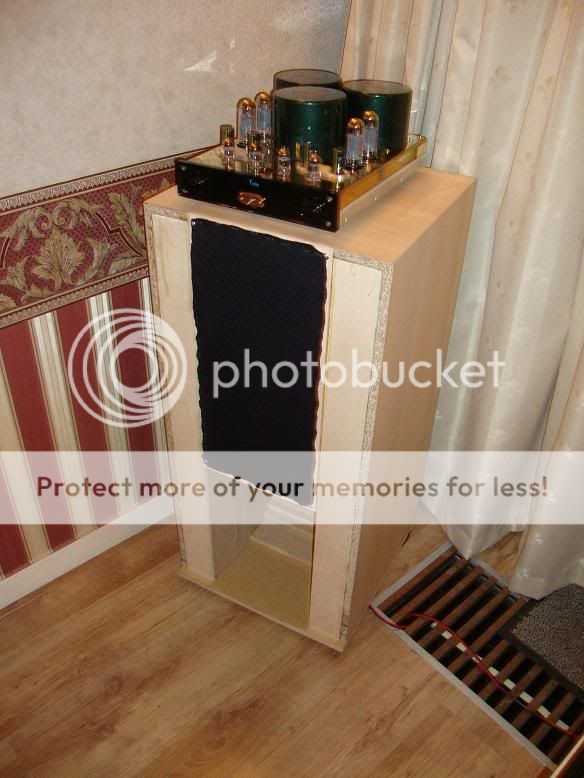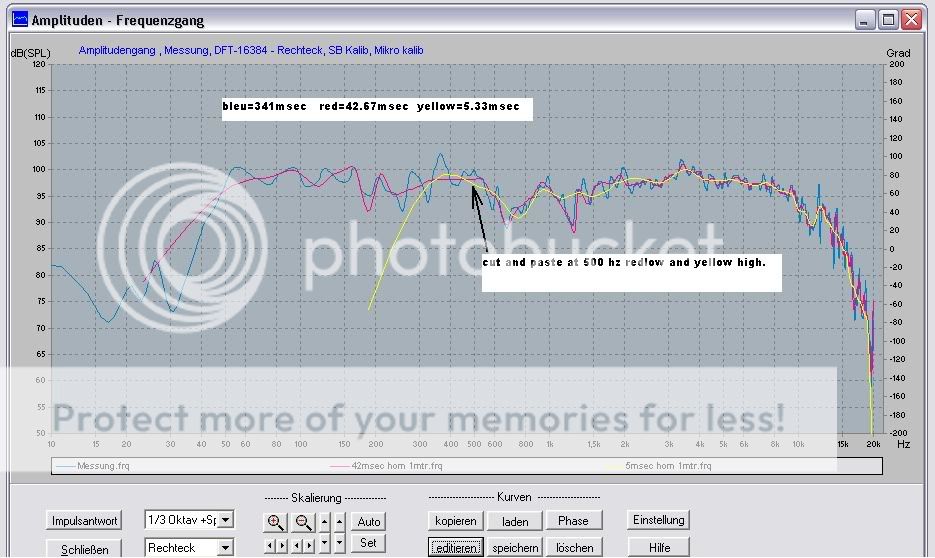Paba,
After simulation and check on frequency response I don't have found a good B&C woofer to use
After simulation and check on frequency response I don't have found a good B&C woofer to use
Very soon I will start the design of the crossover and I will do many measurements.
See the photos of box at the end of the web page (very big!).
See the photos of box at the end of the web page (very big!).
Crossover
=== Preliminary ====
Audiodesign,
I'm still perfecting around this crossover and so far I'm happy with the sound.
Horn needs L-pad (not shown) just little bit attenuation.
Just giving an idea. If you try on real speaker (not simulation) give me your feedback.
=== Preliminary ====
Audiodesign,
I'm still perfecting around this crossover and so far I'm happy with the sound.
Horn needs L-pad (not shown) just little bit attenuation.
Just giving an idea. If you try on real speaker (not simulation) give me your feedback.
Attachments
Last edited:
The box looks great - very nice!
That's also a very nice wood shop in the photos. 🙂
The measurements of the Beyma driver and horn look very good. You might want to try HOLMIpulse
http://www.holmacoustics.com/holmimpulse.php for measurements. It's good, easy to use and free.
You will want to pay special attention to phase when building your crossover. Also look at distortion at the low end of the horn.
Nice project, looking forward to seeing more.
That's also a very nice wood shop in the photos. 🙂
The measurements of the Beyma driver and horn look very good. You might want to try HOLMIpulse
http://www.holmacoustics.com/holmimpulse.php for measurements. It's good, easy to use and free.
You will want to pay special attention to phase when building your crossover. Also look at distortion at the low end of the horn.
Nice project, looking forward to seeing more.
Cool. I have not used it, but understand it is quite good.
How does it display phase and distortion?
How does it display phase and distortion?
For this large loudspeakers it is impossible use the normal damping articles for loudspeakers because in this case the cost would exceed the cost of wood.
Following the suggestion of my friend Andrea of PuntoMusica I have used two different damping materials used in the cars:
1) panels composed of fabric processing residues bottom tar for the base and the back
2) moquette with longhaired and bottom in lute
see photos:
Hi-End and Hi-Eff loudspeakers system
In an initially test with an improvised filter and still without damping the result is a sound pleasant and not tired with many details.
WF 12dB/oct. 1.4mH 22uF
TW 6dB/oct. 10uF in series with 8ohm
Following the suggestion of my friend Andrea of PuntoMusica I have used two different damping materials used in the cars:
1) panels composed of fabric processing residues bottom tar for the base and the back
2) moquette with longhaired and bottom in lute
see photos:
Hi-End and Hi-Eff loudspeakers system
In an initially test with an improvised filter and still without damping the result is a sound pleasant and not tired with many details.
WF 12dB/oct. 1.4mH 22uF
TW 6dB/oct. 10uF in series with 8ohm
Hello,
some low cost materials that I have used in the past include:
tar paper (construction material, purchased in home hardware store)
pillow stuffing purchased in a textile and linen store
egg crates, from my own family weekly consumption of eggs
carpet and underpading purchased in home decoration store
go exploring in home construction/renovation stores lots of nice materials cut in panels and rolls.
cheers
Paba
some low cost materials that I have used in the past include:
tar paper (construction material, purchased in home hardware store)
pillow stuffing purchased in a textile and linen store
egg crates, from my own family weekly consumption of eggs
carpet and underpading purchased in home decoration store
go exploring in home construction/renovation stores lots of nice materials cut in panels and rolls.
cheers
Paba
That looks good! In fact very good for a first try.
How close are you to your subjective sound quality target?
How close are you to your subjective sound quality target?
Hi andrea,
I see your measuring window is very long to increase reliable results, you must choose a window small enough to discriminate the reflections.
I use Hobbybox V6. To measure frequency's down to 23Hz I use a 42,67msec window.
And a 5,33msec window for frequencies above 188Hz. In hobbybox I can paste the two graphics to each other I would paste it around 500Hz.
Then you have the best result with out reflections.
When I am honest to you, with a 341 msec window you ad so much reflections it is only interesting for frequencies lower then 50Hz down to 1,3Hz. It is hard to not make wrong measurements.

I am just happen to be measuring my own new creation at the moment. A 102-105dB horn system down to 35 Hz.

Here the result of my own speaker to show you the difference with the length of your measuring window.
Measured right now in my living room 1mtr for the speaker the spl level is not calibrated to 1Watt so it is only a indication. Only to show the effect on the flatness of the measure result.
bleu 341 msec
red 42 msec
yellow 5,3 msec

Measured right now in my living room 1mtr for the speaker the spl level is not calibrated to 1Watt so it is only a indication. Only to show the effect on the flatness of the measure result.
bleu 341 msec
red 42 msec
yellow 5,3 msec

Last edited:
This is my measurement. Sorry for room reflections. dB is not calibrated to meter. I need to adjust around 50Hz.The ports are at the back of the speaker.
Attachments
Last edited:
This is my measurement. Sorry for room reflections. dB is not calibrated to meter. I need to adjust around 50Hz.
Looks very decent. But what where your settings of the MLS software.
Where did you place the microphone.
Looks very decent. But what where your settings of the MLS software.
Where did you place the microphone.
At 1 metre on average axis between horn and woofer axis. I'm not an expert in this kind of measurement but I hope the mic location is right.
Last edited:
1/3 Octave smoothing
1/3 Octave smoothing graph. Although I listen with valve amp the measurement was made using a good solid state amp.
1/3 Octave smoothing graph. Although I listen with valve amp the measurement was made using a good solid state amp.
Attachments
Last edited:
apelizzo
your crossover frequecy since to be a little bit too high could you chek it with the plot of both driver separated ?
I will do new measurements today using different times.
your crossover frequecy since to be a little bit too high could you chek it with the plot of both driver separated ?
I will do new measurements today using different times.
- Home
- Loudspeakers
- Multi-Way
- Hi-End and Hi-Efficency loudspeakers (horn + onken)




